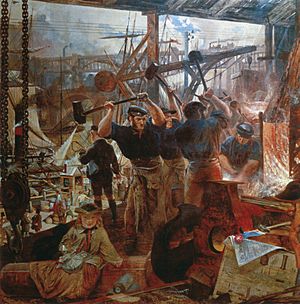Industrial Age facts for kids
The Industrial Age was a time in history when big changes happened in how people worked and lived. It started around 1760 in Great Britain. During this time, people stopped using hand tools so much. Instead, they started using powerful machines like the power loom (for weaving cloth) and the steam engine. Factories also became very common, bringing many workers together.
Some people think the Industrial Age ended in the late 1900s, replaced by the Information Age. But even today, many developing countries still rely a lot on manufacturing. Even though mobile phones are now common everywhere, the Industrial Age's impact is still felt.
Contents
How the Industrial Age Began
The Industrial Age started in Great Britain in the mid-1700s. Big changes in farming methods helped make this possible. This "agricultural revolution" began in the Netherlands and was later improved by the British.
Britain had everything needed for this revolution to start. It had "factors of production":
- Land: This means all natural resources, like coal mining from places such as Wales and County Durham. Britain also had many harbors for trade.
- Capital: This refers to money and goods like tools, machines, and equipment.
- Labor: Britain had many people available to work in factories.
Britain also had a huge market for its goods, both at home and in its colonies overseas. Its powerful navy and merchant ships helped it trade all over the world. The British government also supported businesses, which was very important.
The invention of the steam engine was a game-changer. It led to steamboats and locomotives, making transportation much faster. By the mid-1800s, the Industrial Revolution had spread to Continental Europe and North America. Since then, it has reached most of the world.
The Textile Industry Changes
The cotton industry was the first to use mechanization. This means using automatic machines to make things faster. Before factories, businesses would give raw cotton to people. These people would spin and weave the cotton into cloth from their homes. This was called the "domestic system."
Then, new inventions changed everything:
- In 1764, James Hargreaves invented the spinning jenny. This machine could make eight times more thread than a single spinning wheel.
- Richard Arkwright later made the spinning jenny work with water power. He then opened a spinning mill, which was the start of the factory system.
- In 1785, Edmund Cartwright invented a loom that was also powered by water.
These inventions meant that cloth could be made much faster and cheaper in factories.
The Power of Steam Engines
Steam engines were a key invention of the Industrial Age.
- In 1712, Thomas Newcomen created the first successful steam engine.
- In 1769, James Watt patented an improved, more modern steam engine.
Because of Watt's engine, steam replaced water as the main power source for industries. Steam engines made transportation much faster with steamboats and locomotives. This helped the Industrial Revolution spread quickly.
The Industrial Age brought many other changes, including:
- Mass production (making many identical items quickly).
- Broadcasting (sending out information, like radio).
- The rise of the nation state (countries with their own governments).
- New ways to create power.
- Advances in modern medicine.
- The spread of running water in homes.
Life expectancy around the world has more than doubled since the Industrial Revolution began. This shows how much the quality of human life improved during this period.
See also
- Information age
- Imagination age


